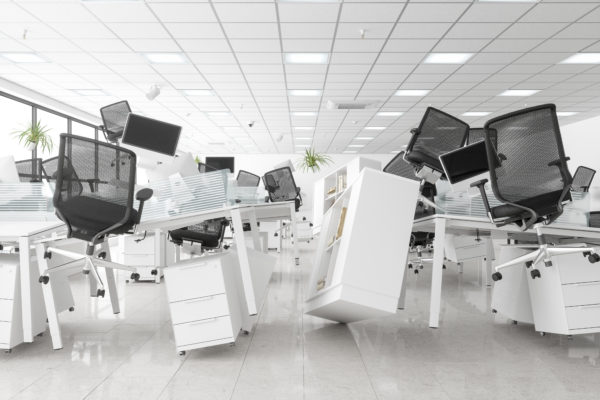Do you work at an organization that houses dozens, hundreds, or thousands of microfilm rolls? If you use these records on a daily basis to get your work done, then you may recognize that it’s cumbersome and downright inconvenient. Microfilm is a great storage medium but it’s nowhere close to being the easiest material to handle nor is it the most accessible.
If you find yourself wondering if it’s time to convert your microfilm collection to a digital format, here are 6 reasons why your organization needs microfilm scanning.
1. Your Records Are Deteriorating
Have you noticed that some of your most frequently used microfilm records are not in the same conditions they once were? Microfilm has a shelf life of up to 500 years but only if it’s stored and handled properly; when it’s not stored optimally or if the rolls are in constant use, the shelf life goes down exponentially.
Since microfilm has very specific storage requirements (in cool, dry, stable environments with limited exposure to light and pollutants), it’s not uncommon to see microfilm deterioration. There are three top signs that your microfilm is decaying: if your microfilm starts smelling like vinegar, orange spots start appearing on the microfilm, or if it’s flaking and falling apart.
The first sign is known as vinegar syndrome, where the acetate chemicals in the film start breaking down and making your film smell sour like vinegar. Once this starts happening, your film will start deteriorating at a faster rate. The second sign is when orange (sometimes red and yellow) spots start appearing on your microfilm is known as redox. It’s caused by the oxidation of silver in the microfilm with elements such as moisture, air, and contaminants. And the third sign, where your microfilm is flaking or falling apart, is known as embrittlement. This usually occurs when the film loses its elasticity, which makes the film more fragile. When embrittlement occurs, it becomes difficult to reverse the effects.
If you notice that your microfilm is exhibiting any of these signs, then you have to act fast. Deterioration happens rapidly and there’s a chance you can lose the records on these rolls forever. One way to prevent this situation from happening is by scanning and digitizing your microfilm records so you can save the data that was on them in an electronic format.
2. You Have A Hard Time Locating The Records You Need
Even if your organization has spent a lot of time filing and setting up a retrieval system for your microfilm, there’s still a chance that you’re spending more time than you want to locate needed records. When a record request comes in (from your boss, colleague, customer, etc.), you have to stop what you’re doing to go locate the microfilm roll that the requested record is on, load it onto a reader printer to look for the specific section needed, supply the document to the person that requested it, and then put the microfilm reel back to where it’s supposed to be. This whole process takes time and can be tedious depending on the record. You can be spending ten minutes or more to locate one record.
If reading the scenario above struck a chord with you, then chances are you’re probably spending a lot of time locating records and your organizations can have more efficient methods of records retrieval. The time spent searching for documents can hurt your team’s productivity. By scanning your microfilm records, you can easily improve records retrieval and accessibility. When a record request comes in, you can simply search for the electronic documents right from your computer and locate the requested record in a matter of minutes depending on how you index your files. You’ll be able to cut down the time to fulfill record requests and, if your organization deals directly with customers, the speed of document delivery can greatly increase customer satisfaction.

3. You’re Spending More Money On Storage Than You Want To
If one thing’s a given, it’s that microfilm requires space to store. You have to find and make space in your office for cabinets to store your microfilm collection. This might not be as big of an issue if you have a decent-sized office. However, if you have a lot of microfilm and limited space, then you have to keep them at an off-site storage facility. Sure, you might find a cheap storage facility that fits into your budget, but this is a continual investment that you’ll have to pay as long as you want them to store your microfilm records. That cost will add up over time.
On the other hand, if you scan your microfilm, there will be a high up-front cost but it’ll likely be a one-time investment. Once you complete your scanning project and if your industry doesn’t require you to keep your physical copies, you can dispose of your physical microfilm records and eliminate that storage cost altogether.

4. You Don’t Have A Backup Disaster Recovery Plan In Place
Another sign of why you need to scan your microfilm is if you don’t have backups of your records. Many organizations don’t make duplicates of their hard copy records since it’s pricey and can seem unnecessary. But that’s almost as if you’re waiting for an accident to happen because disasters can strike at any time. Fires, floods, hurricanes, tornadoes, earthquakes, burst pipes, gas leaks, structural collapse, or theft are a few things that your organization could face. If one of these scenarios struck your organization, you could potentially lose your most important documents forever. According to the Federal Emergency Management Agency (FEMA), 1 in 5 companies doesn’t have a disaster recovery plan in place. When a disaster strikes, 40-60% of companies (most of which don’t have a recovery plan) never reopen after a disaster, and 25% fail after a year. Facing a disaster is distressing, costly, and there’s a chance your organization will never fully recover.
To become well-equipped to handle a disaster scenario, it’s wise to create backups of your microfilm records. One way to do this is by digitizing your microfilm so you’ll have backup digital copies of your records. Once you have electronic records, you’re able to keep and access them through a cloud-hosted system or an internal shared network. Even if a disaster strikes you, you’ll be prepared and will be able to restart your business processes quickly.

5. Images On Your Microfilm Are Illegible Or Difficult To Read
Since your organization utilizes microfilm, then you might be familiar with using some sort of reader printers or film scanners such as a Canon, Minolta, or ScanPro. Most film scanners have basic image enhancement settings (brightness, contrast, etc.) and give you the ability to save and export the image in the format of your choice. However great these settings may be, the hardware can be limiting if you have to manually adjust images and physically handle your microfilm. And even with these adjustment capabilities, the capabilities of some scanner units may not get you the optimal image you’re looking for. For certain documents, you may need more advanced settings to be able to properly view your record.
Another limitation of film scanners is that you’ll have to enhance the image before you scan the film at the scanner station. If you find that what you scanned and saved is not optimal, you’ll have to load it onto the scanner, manipulate the image again, scan it, and see how it’ll turn out. This is a bit time-consuming and may not yield the results you want or need.
When you digitize your microfilm, most scanning services will give you two electronic versions of your records: a black-and-white version and a grayscale version. If your original records didn’t have the best quality to begin with and are not as legible as you’d like once they’re scanned, you can use tools that have more advanced image enhancement capabilities to improve your images and ensure readability. For example, with our Digital ReeL application, you’ll have built-in image adjustment tools to enhance your digital images, adjust the brightness and contrast levels, crop the image, and save and export your documents.
6. You’re Worried Your Organization Is Not Modern Enough
In today’s world, technology is rapidly redefining how the workforce operates. If organizations are not changing promptly to meet the demands of the digital world, this can hurt them or they can even be left behind.
Microfilm was once used as an active information system, but there have been many technological innovations since then. Because of these new technologies, microfilm can often be seen as “outdated.” We now live in a world where digital technology surrounds us and we can access anything in the palms of our hands (ex. mobile devices). We expect instant access and shareability. The process of retrieving microfilm, loading it onto a bulky outdated reader printer, and scanning it requires a lot of labor and time. This is one of the main reasons why digitization is such a popular option and continues to be on the rise today.
Having documents in digital format allows for quick access and shareability. Your workers will have the option to access and share documents instantaneously and from almost anywhere if it’s permitted. This change will increase your organization’s information flow and productivity. You can have a complete overhaul of your information management system and get rid of your reader printers and film scanners once and for all. Being agile to technological changes instead of resisting them will undoubtedly improve your business processes and bring many benefits to your organization.
Conclusion
If you relate to one or more signs in this article, then it may be time for you to consider microfilm scanning and digitization. By scanning your microfilm, you can safeguard your records from deterioration, save money on storage space, protect your organization from disasters, increase record accessibility, and modernize your organization. You’ll be able to preserve your organization’s most important records while also ensuring that your business processes are capable of handling anything and everything. The time to scan your microfilm is now!
Next Steps
Reach out to us today! Click the “Get Your Quote” button below, fill out the form, and we’ll quickly reply to you to discuss your project.
Further Reading
Here are other articles we’ve put together about microfilm scanning to give you a better understanding of your conversion project:
“How Long Will A Microfilm Scanning Project Take?” presents various factors that affect project timelines such as quantity and type of microfilm, indexing requirements, and project complexity. The article provides three different projects as examples.
“How Much Does Microfilm Scanning Cost?” covers one of the most important aspects of a scanning project: the cost. This article gives general microfilm scanning prices and covers 9 different factors that could affect your scanning project, such as quantity, microfilm type, and desired outputs.
“The BMI Microfilm Scanning Process” gives an overview of our 10-step microfilm scanning process that takes your physical microfilm records and turns them into digital. There’s an infographic provided that breaks down the different components of the project.

